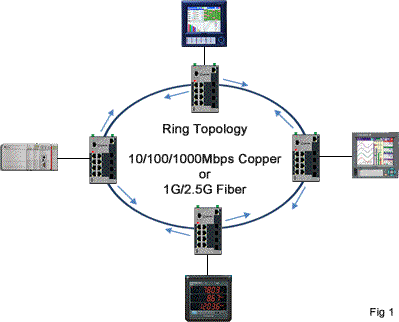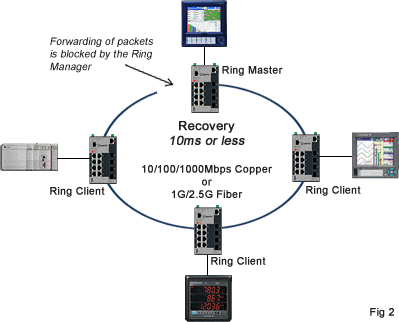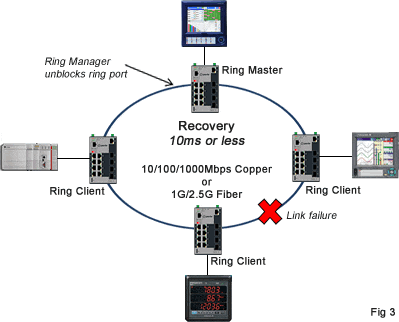Ring Protocol MRP (IEC 62439-2)
Media Redundancy Protocol (MRP) is a standards-based protocol used in Ring topologies to avoid single points of failure by providing a recovery time of 10ms or less.
In a ring network, each Ethernet switch is connected to a minimum of two other switches to form a ring. Ease of set-up and high-speed performance make Ring topology networks incredibly popular in factories, on plant floors, and other Industrial Ethernet environments. Two other main benefits include:
- Each switch has a redundant connection (link) into the network.
- It provides a more cost-effective cabling infrastructure than using an aggregation switch at a central location.

However, if one node or port goes down, the entire network is affected. Therefore, the administrator must have a recovery plan in place. The failure of a single point can lead to an entire production facility being disabled.
The problem with switch loop scenarios and Spanning Tree protocols
The disadvantage of forming a ring network using switches is that this topology can introduce a “switch loop” condition that creates broadcast storms. These storms occur when broadcasts and multicasts are forwarded by the switches out of every port. If a destination for the message cannot be found, the switches will repeatedly rebroadcast the messages, flooding the network. Since the Layer 2 header does not support a Time-to-Live (TTL) value, if a frame is sent into a looped topology, it can loop forever severely consuming all available bandwidth on the ring making the network unusable. This condition can block all other network traffic and will eventually result in a network meltdown.
One resolution to this problem is to simply break the loop somewhere in the ring. Spanning Tree protocols, such as RSTP, were developed to detect these switch loop conditions and then intelligently reconfigure the network to provide the break that eliminates the switch loop scenario. Also, if anything happens in the network, a topology change notification is sent out to create a different safe path.
Although effective enough for many networks, Spanning Tree protocols take a relatively long time to complete this re-convergence. RSTP, for example, can take several seconds for the network to recover. This is not good enough for mission-critical industrial Ethernet applications.
Why MRP ICE62439-2 is needed in Ring topology networks
Media Redundancy Protocol (MRP) is a standards-based protocol (IEC 62439-2) that provides a recovery time of 10ms or less, fault-tolerance, and load balancing. The way MRP works is that a “Ring Manager” switch will drop (block) all packet forwarding on one of its two designated ring ports (Fig 2), to break the switch loop. All traffic from devices connected to the switches in the loop will still have a path to each other, with redundant links, but without the harmful switch loop.

The Ring Manager is in constant communication with its MRP peers. If one of the links on any of the other ring nodes detects a failure, the client node will send a message to the Ring Manager which will then unblock its blocked port re-enabling communication between all of the switches (Fig 3).

Special poll packets that can traverse blocked ports are sent around the ring and monitored by the Ring Manager. If the Ring Manager does not see its poll packets come back around the ring, it knows that one of the switch nodes, or even a switch/hub that does not support MRP, has failed. The Ring Manager will then unblock its port and resume the forwarding of packets on both of its ring ports. All devices on switches, except the failed node, will again have a path to each other.
During these topology change events, the various switches on the ring will be informed to clear the MAC tables that they have built-up so they can re-learn the port to destination MAC addresses of the devices connected to the ring.
MRP is the gold standard for network redundancy. Given the intelligence behind the protocol, it is strongly recommended that each switch node in the ring supports MRP to ensure interoperable with other major Ring Protocol vendors like Siemens, Cisco, and Belden.
